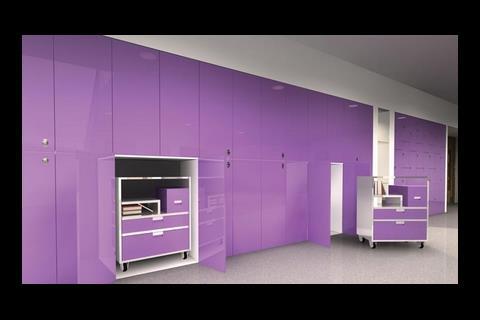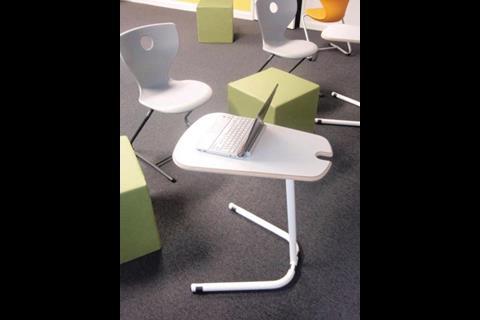A flexible approach to school design doesn’t usually start with the furniture and equipment. But if we want to make best use of teaching spaces, maybe it should
Giant bean bags, surf tables, cube stalls, biometric laptop-charging lockers and mobile science stations. If all this sounds a world away from the stacking tables and TV trolleys of your old school, that’s because there’s been a massive shift in attitude to how schools should be kitted out.
Even since the first wave of Building Schools for the Future (BSF) schemes, where the government was looking to transform the way children were educated, the approach to furniture, fittings and equipment (FF&E) has changed.
Caroline Buckingham, director of architect HLM, which has completed a number of BSF schools and is working on further bids, says the whole idea about transformational learning is creating flexible spaces.
Open-plan, double-height rooms and break-out spaces are becoming de rigueur; the problem is that the potential of these spaces is often not matched by the way they are fitted out and furnished.
Local authorities still procure the same 30 tables and chairs they always have, complains Buckingham. “In the past couple of years we’ve started to realise that what is going to have more of an impact on the learning environment is a ‘cocktail of furniture’ that allows the spaces we’ve created to be used flexibly and meet the educational vision of the school.”
Chris Grasby, director of education at architect HKS, says the practice’s role in specification and design of the FF&E is growing because of the need to fully interpret the educational vision. What it comes down to, he says, is how you put groups of people together. “You can design a space to have the right proportions to allow for flexibility and different arrangements but you then need to have the furniture to make it happen. It’s designing from the inside out.”
One of the hurdles that has prevented this is the procurement process. Traditionally, FF&E has been at the end of the supply chain and is not considered in detail until the later stages, says Lawrence Brenchley, director of FFE Consulting. “The whole concept of how the spaces work and how the fixtures and fittings help achieve it needs to be considered at the early stages of design to meet a particular school’s approach to teaching and learning.”
Another sticking point is budgets. Although academies are fairly generously provided for when it comes to FF&E, BSF projects don’t enjoy the same level of funding.
Spending on FF&E is even lower for refurbishments, which often require existing equipment to be re-used. As a result, off-the-peg solutions are desirable, when they’re available.
Buckingham says the challenge for architects is building up that product knowledge. HLM is setting up a showcase in its office of products that teachers and pupils can come and experience. Team a Go-go, a Liverpool-based FF&E consultant, has used its experience designing office and retail interiors and applied them to schools. Kate Stewart, its managing director, says it is not simply about the furniture but about creating aspirational spaces. “Children are savvy consumers of design,” she says.
Bespoke products are often needed if the educational transformation is to be realised. The drawback here is cost. Tooling up for a limited run of furniture is expensive and added to this is the need to test designs to the relevant standards – chairs are a lot more onerous than tables – all that rocking back and forward. Team a Go-go has collaborated with furniture makers to produce products to fill gaps in what is available off-the-shelf. “There’s always been a tension between something being fit for purpose, aspirational and affordable. Often what’s aspired to isn’t engineered to be fit for purpose so we have brought our own products to market,” says Stewart.
FFE’s Brenchley worked with Alsop Architects on a learning plaza called New Line Learning in Oldborough Manor School in Kent. The idea of the plaza is of a large flexible space where a variety of subjects can be taught. “It could be a project to create a DVD in which case there might be a design technology class to make the case, a graphics lesson where the cover is created on a computer, then the music is recorded and edited, and finally they might have a lesson on marketing, all in the same space.” For this whole class seating units, teachers’ resources bays, storage units and island and perimeter tables with ICT accessibility are used, all of which are movable to configure the space to what’s being taught.
It’s not just all about chairs and tables though. “Storage is a huge issue,” says Grasby, along with teaching aids such as white boards. HKS is working with a firm to develop a new type of interactive white board for Hull BSF. “Fixed white boards can lock you into a particular configuration. This one is basically a mobile table onto which is fixed a short throw projector so you free up the arrangement of the room immediately.” The idea is that the table can be used horizontally for interactive working with small groups or flipped vertically to present to a whole room of students.
“There are huge opportunities,” says Grasby. “But its understanding how people will use the spaces and planning the right bits of kit for it. That’s where we as designers can bring a huge amount and make it a seamless process.”
Simulated classrooms
It’s one thing designing a school with flexible spaces to encourage transformational learning, but how do you know it’s going to live up to expectations?
A consortium including multimedia production company Moofu, the Institute of Education, University of London, Birmingham Local Education Partnership (LEP) and the educational planner Dr Kenn Fisher, has developed a new 3D tool that it hopes will transform the planning and use of learning spaces.
Called Levros – Learning Environments Virtual Reality Online Simulator – it offers a fully interactive 3D environment that can be explored using online characters, or avatars.
Teachers and students anywhere in the world can work together to experiment with furniture, resources and layout, moving them freely to modify environments. With this ability to manipulate objects and positioning, the effectiveness of learning environments can be tested.
A significant advantage of Levros over existing simulators, claims the company, is its capability to allow the insertion of any architectural design 3D model so that any design concept can be tested by the users to provide feedback for the designers to make improvements.
The Birmingham LEP is using the tool to help guide the Building Schools for the Future (BSF) project in the city and will make it available to anyone in the UK who is working on BSF projects.
Original print headline - all about the kit
Downloads
Floorplan
Other, Size 0 kb
Specifier 12 February 2010

Specifier 12 February 2010
- 1
- 2
- 3
 Currently
reading
Currently
reading
All about the kit: school furniture and equipment
- 5
- 6
- 7
- 8
- 9
- 10







































No comments yet